Marketing and Management: A Case Study of Fonterra in the United States
VerifiedAdded on 2023/06/03
|9
|3116
|295
AI Summary
This essay discusses Fonterra's strategy to operate as a milk ingredient supplier, not as a food company, and how it collaborated with Dairy Farmers of America to avoid market competition and minimize risks in the United States. It explains the management theories and modern marketing theory that explain this strategy.
Contribute Materials
Your contribution can guide someone’s learning journey. Share your
documents today.
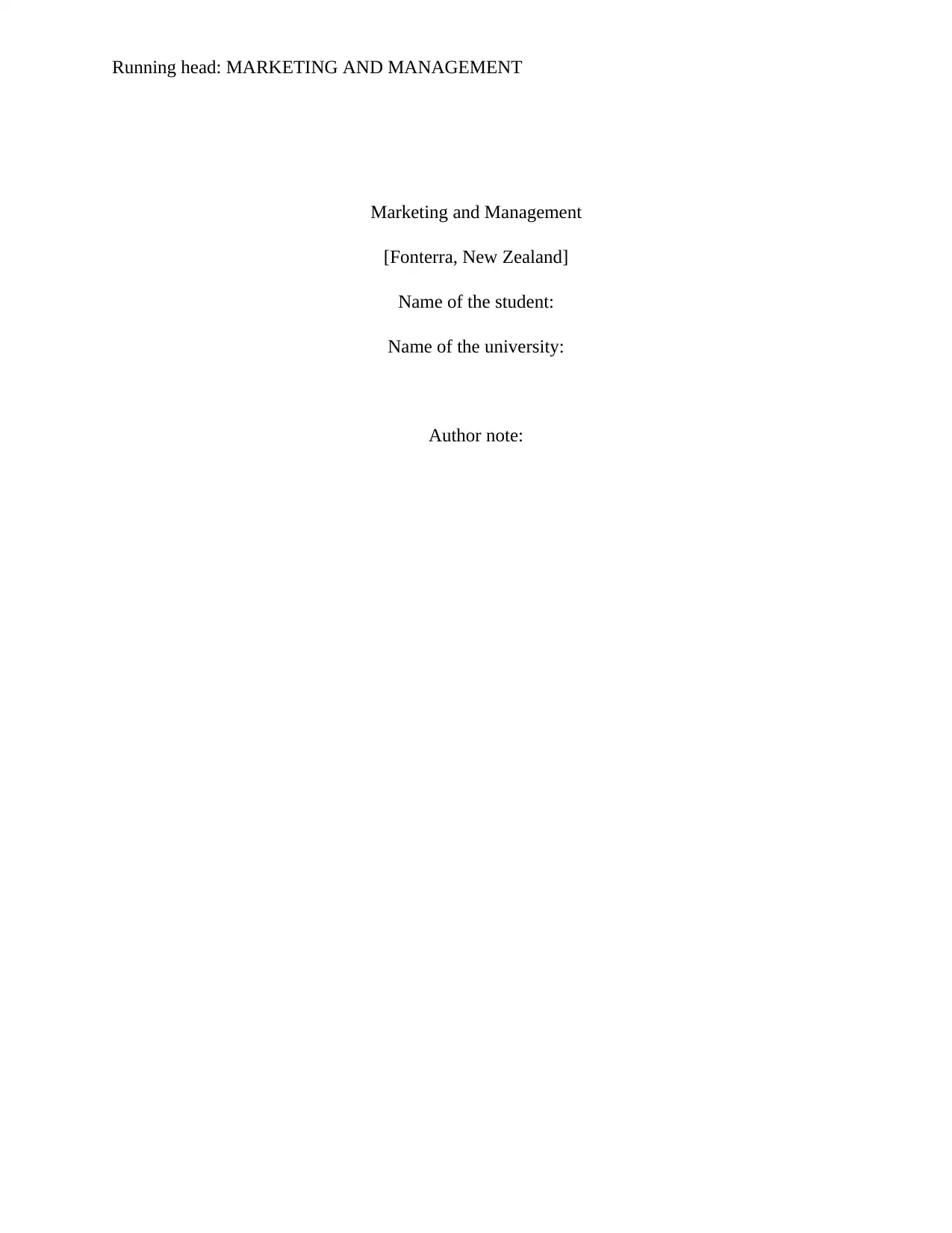
Running head: MARKETING AND MANAGEMENT
Marketing and Management
[Fonterra, New Zealand]
Name of the student:
Name of the university:
Author note:
Marketing and Management
[Fonterra, New Zealand]
Name of the student:
Name of the university:
Author note:
Secure Best Marks with AI Grader
Need help grading? Try our AI Grader for instant feedback on your assignments.
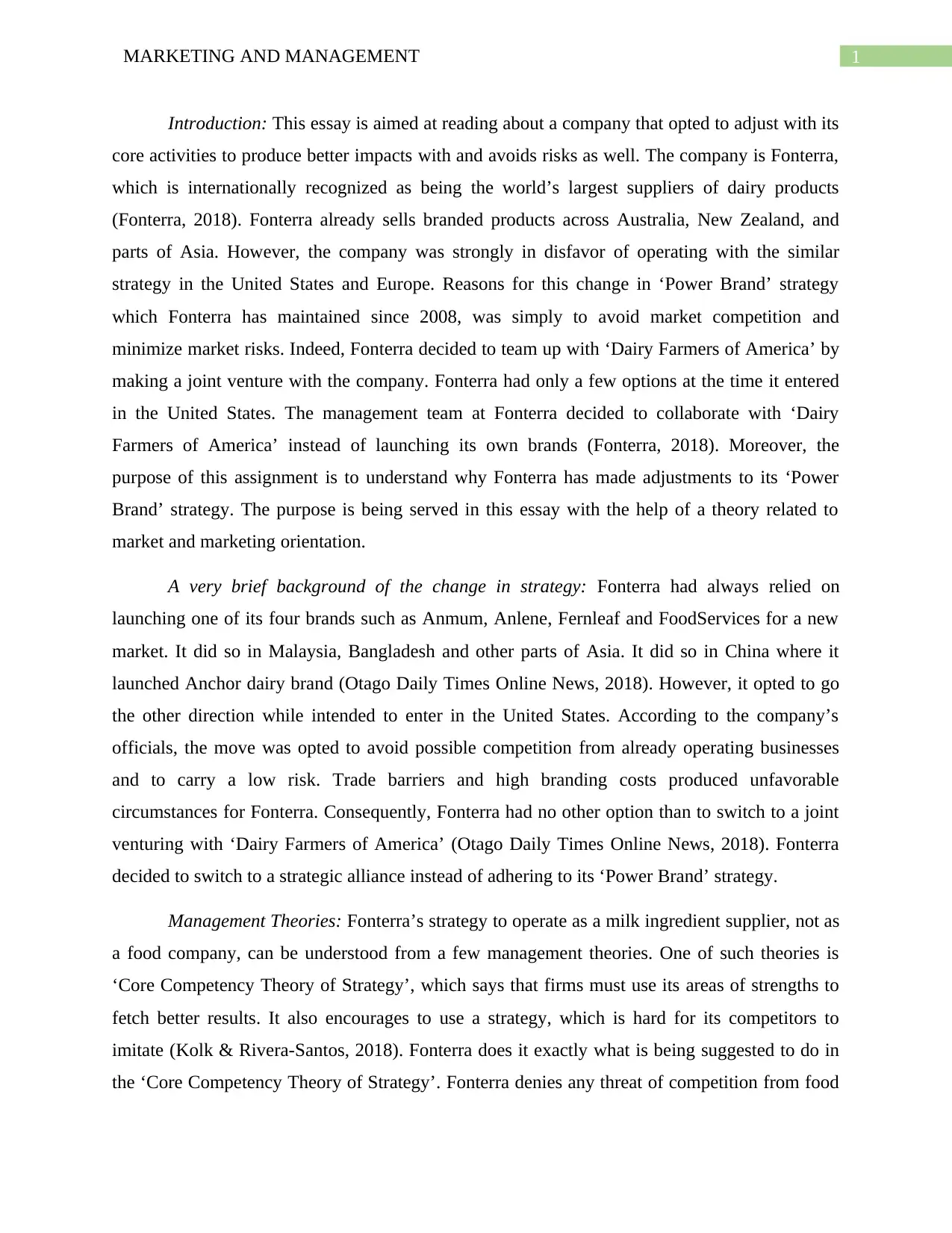
1MARKETING AND MANAGEMENT
Introduction: This essay is aimed at reading about a company that opted to adjust with its
core activities to produce better impacts with and avoids risks as well. The company is Fonterra,
which is internationally recognized as being the world’s largest suppliers of dairy products
(Fonterra, 2018). Fonterra already sells branded products across Australia, New Zealand, and
parts of Asia. However, the company was strongly in disfavor of operating with the similar
strategy in the United States and Europe. Reasons for this change in ‘Power Brand’ strategy
which Fonterra has maintained since 2008, was simply to avoid market competition and
minimize market risks. Indeed, Fonterra decided to team up with ‘Dairy Farmers of America’ by
making a joint venture with the company. Fonterra had only a few options at the time it entered
in the United States. The management team at Fonterra decided to collaborate with ‘Dairy
Farmers of America’ instead of launching its own brands (Fonterra, 2018). Moreover, the
purpose of this assignment is to understand why Fonterra has made adjustments to its ‘Power
Brand’ strategy. The purpose is being served in this essay with the help of a theory related to
market and marketing orientation.
A very brief background of the change in strategy: Fonterra had always relied on
launching one of its four brands such as Anmum, Anlene, Fernleaf and FoodServices for a new
market. It did so in Malaysia, Bangladesh and other parts of Asia. It did so in China where it
launched Anchor dairy brand (Otago Daily Times Online News, 2018). However, it opted to go
the other direction while intended to enter in the United States. According to the company’s
officials, the move was opted to avoid possible competition from already operating businesses
and to carry a low risk. Trade barriers and high branding costs produced unfavorable
circumstances for Fonterra. Consequently, Fonterra had no other option than to switch to a joint
venturing with ‘Dairy Farmers of America’ (Otago Daily Times Online News, 2018). Fonterra
decided to switch to a strategic alliance instead of adhering to its ‘Power Brand’ strategy.
Management Theories: Fonterra’s strategy to operate as a milk ingredient supplier, not as
a food company, can be understood from a few management theories. One of such theories is
‘Core Competency Theory of Strategy’, which says that firms must use its areas of strengths to
fetch better results. It also encourages to use a strategy, which is hard for its competitors to
imitate (Kolk & Rivera-Santos, 2018). Fonterra does it exactly what is being suggested to do in
the ‘Core Competency Theory of Strategy’. Fonterra denies any threat of competition from food
Introduction: This essay is aimed at reading about a company that opted to adjust with its
core activities to produce better impacts with and avoids risks as well. The company is Fonterra,
which is internationally recognized as being the world’s largest suppliers of dairy products
(Fonterra, 2018). Fonterra already sells branded products across Australia, New Zealand, and
parts of Asia. However, the company was strongly in disfavor of operating with the similar
strategy in the United States and Europe. Reasons for this change in ‘Power Brand’ strategy
which Fonterra has maintained since 2008, was simply to avoid market competition and
minimize market risks. Indeed, Fonterra decided to team up with ‘Dairy Farmers of America’ by
making a joint venture with the company. Fonterra had only a few options at the time it entered
in the United States. The management team at Fonterra decided to collaborate with ‘Dairy
Farmers of America’ instead of launching its own brands (Fonterra, 2018). Moreover, the
purpose of this assignment is to understand why Fonterra has made adjustments to its ‘Power
Brand’ strategy. The purpose is being served in this essay with the help of a theory related to
market and marketing orientation.
A very brief background of the change in strategy: Fonterra had always relied on
launching one of its four brands such as Anmum, Anlene, Fernleaf and FoodServices for a new
market. It did so in Malaysia, Bangladesh and other parts of Asia. It did so in China where it
launched Anchor dairy brand (Otago Daily Times Online News, 2018). However, it opted to go
the other direction while intended to enter in the United States. According to the company’s
officials, the move was opted to avoid possible competition from already operating businesses
and to carry a low risk. Trade barriers and high branding costs produced unfavorable
circumstances for Fonterra. Consequently, Fonterra had no other option than to switch to a joint
venturing with ‘Dairy Farmers of America’ (Otago Daily Times Online News, 2018). Fonterra
decided to switch to a strategic alliance instead of adhering to its ‘Power Brand’ strategy.
Management Theories: Fonterra’s strategy to operate as a milk ingredient supplier, not as
a food company, can be understood from a few management theories. One of such theories is
‘Core Competency Theory of Strategy’, which says that firms must use its areas of strengths to
fetch better results. It also encourages to use a strategy, which is hard for its competitors to
imitate (Kolk & Rivera-Santos, 2018). Fonterra does it exactly what is being suggested to do in
the ‘Core Competency Theory of Strategy’. Fonterra denies any threat of competition from food
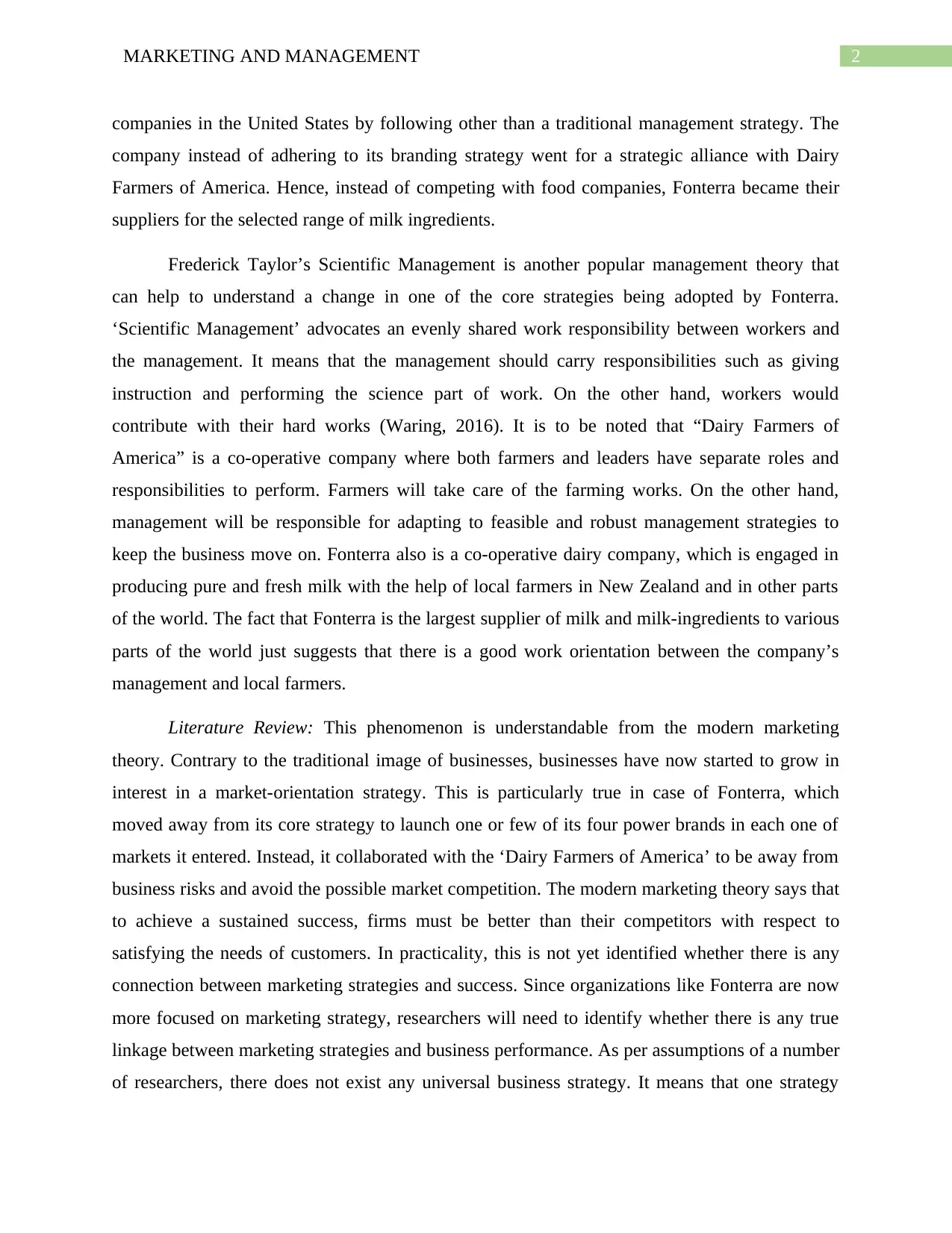
2MARKETING AND MANAGEMENT
companies in the United States by following other than a traditional management strategy. The
company instead of adhering to its branding strategy went for a strategic alliance with Dairy
Farmers of America. Hence, instead of competing with food companies, Fonterra became their
suppliers for the selected range of milk ingredients.
Frederick Taylor’s Scientific Management is another popular management theory that
can help to understand a change in one of the core strategies being adopted by Fonterra.
‘Scientific Management’ advocates an evenly shared work responsibility between workers and
the management. It means that the management should carry responsibilities such as giving
instruction and performing the science part of work. On the other hand, workers would
contribute with their hard works (Waring, 2016). It is to be noted that “Dairy Farmers of
America” is a co-operative company where both farmers and leaders have separate roles and
responsibilities to perform. Farmers will take care of the farming works. On the other hand,
management will be responsible for adapting to feasible and robust management strategies to
keep the business move on. Fonterra also is a co-operative dairy company, which is engaged in
producing pure and fresh milk with the help of local farmers in New Zealand and in other parts
of the world. The fact that Fonterra is the largest supplier of milk and milk-ingredients to various
parts of the world just suggests that there is a good work orientation between the company’s
management and local farmers.
Literature Review: This phenomenon is understandable from the modern marketing
theory. Contrary to the traditional image of businesses, businesses have now started to grow in
interest in a market-orientation strategy. This is particularly true in case of Fonterra, which
moved away from its core strategy to launch one or few of its four power brands in each one of
markets it entered. Instead, it collaborated with the ‘Dairy Farmers of America’ to be away from
business risks and avoid the possible market competition. The modern marketing theory says that
to achieve a sustained success, firms must be better than their competitors with respect to
satisfying the needs of customers. In practicality, this is not yet identified whether there is any
connection between marketing strategies and success. Since organizations like Fonterra are now
more focused on marketing strategy, researchers will need to identify whether there is any true
linkage between marketing strategies and business performance. As per assumptions of a number
of researchers, there does not exist any universal business strategy. It means that one strategy
companies in the United States by following other than a traditional management strategy. The
company instead of adhering to its branding strategy went for a strategic alliance with Dairy
Farmers of America. Hence, instead of competing with food companies, Fonterra became their
suppliers for the selected range of milk ingredients.
Frederick Taylor’s Scientific Management is another popular management theory that
can help to understand a change in one of the core strategies being adopted by Fonterra.
‘Scientific Management’ advocates an evenly shared work responsibility between workers and
the management. It means that the management should carry responsibilities such as giving
instruction and performing the science part of work. On the other hand, workers would
contribute with their hard works (Waring, 2016). It is to be noted that “Dairy Farmers of
America” is a co-operative company where both farmers and leaders have separate roles and
responsibilities to perform. Farmers will take care of the farming works. On the other hand,
management will be responsible for adapting to feasible and robust management strategies to
keep the business move on. Fonterra also is a co-operative dairy company, which is engaged in
producing pure and fresh milk with the help of local farmers in New Zealand and in other parts
of the world. The fact that Fonterra is the largest supplier of milk and milk-ingredients to various
parts of the world just suggests that there is a good work orientation between the company’s
management and local farmers.
Literature Review: This phenomenon is understandable from the modern marketing
theory. Contrary to the traditional image of businesses, businesses have now started to grow in
interest in a market-orientation strategy. This is particularly true in case of Fonterra, which
moved away from its core strategy to launch one or few of its four power brands in each one of
markets it entered. Instead, it collaborated with the ‘Dairy Farmers of America’ to be away from
business risks and avoid the possible market competition. The modern marketing theory says that
to achieve a sustained success, firms must be better than their competitors with respect to
satisfying the needs of customers. In practicality, this is not yet identified whether there is any
connection between marketing strategies and success. Since organizations like Fonterra are now
more focused on marketing strategy, researchers will need to identify whether there is any true
linkage between marketing strategies and business performance. As per assumptions of a number
of researchers, there does not exist any universal business strategy. It means that one strategy
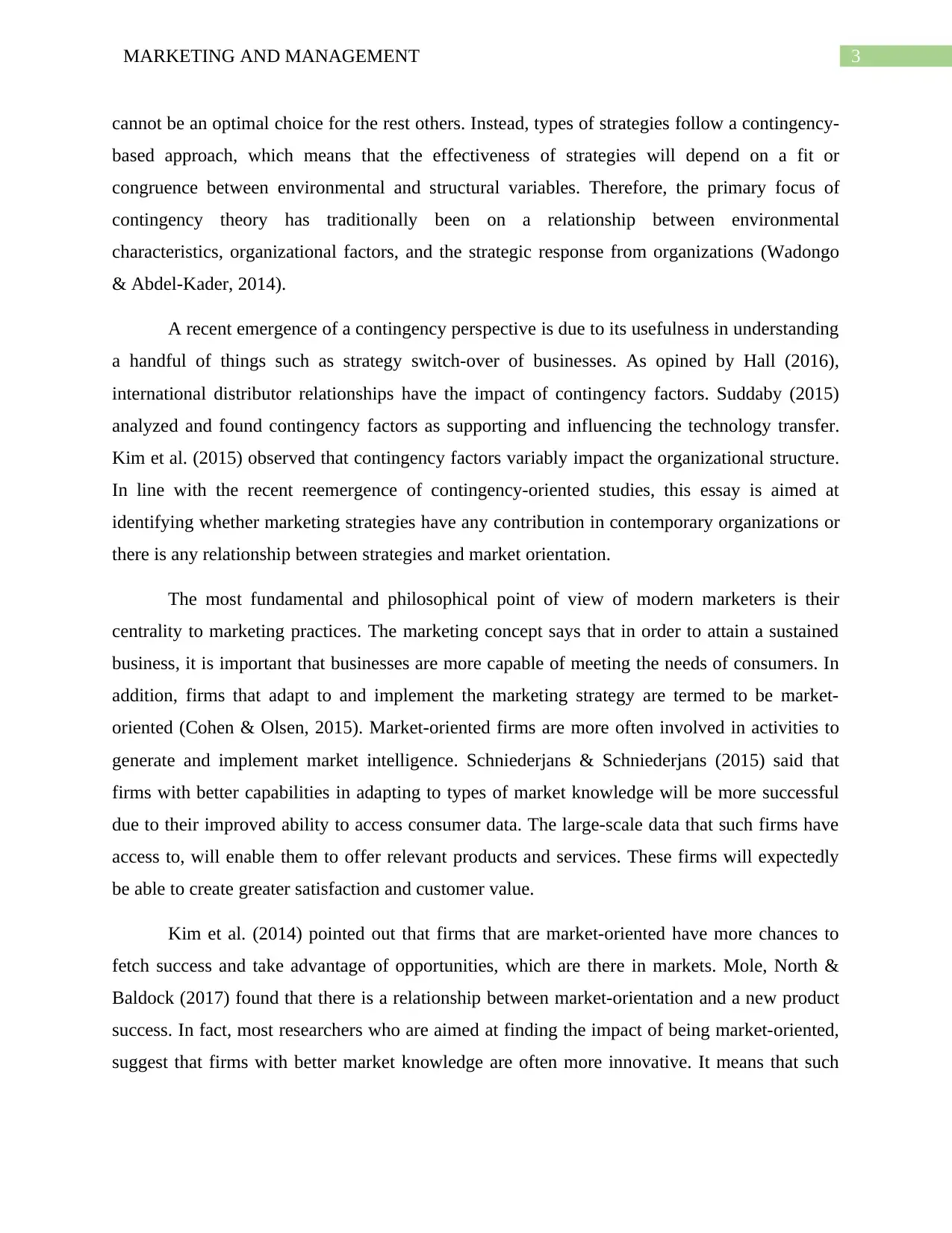
3MARKETING AND MANAGEMENT
cannot be an optimal choice for the rest others. Instead, types of strategies follow a contingency-
based approach, which means that the effectiveness of strategies will depend on a fit or
congruence between environmental and structural variables. Therefore, the primary focus of
contingency theory has traditionally been on a relationship between environmental
characteristics, organizational factors, and the strategic response from organizations (Wadongo
& Abdel-Kader, 2014).
A recent emergence of a contingency perspective is due to its usefulness in understanding
a handful of things such as strategy switch-over of businesses. As opined by Hall (2016),
international distributor relationships have the impact of contingency factors. Suddaby (2015)
analyzed and found contingency factors as supporting and influencing the technology transfer.
Kim et al. (2015) observed that contingency factors variably impact the organizational structure.
In line with the recent reemergence of contingency-oriented studies, this essay is aimed at
identifying whether marketing strategies have any contribution in contemporary organizations or
there is any relationship between strategies and market orientation.
The most fundamental and philosophical point of view of modern marketers is their
centrality to marketing practices. The marketing concept says that in order to attain a sustained
business, it is important that businesses are more capable of meeting the needs of consumers. In
addition, firms that adapt to and implement the marketing strategy are termed to be market-
oriented (Cohen & Olsen, 2015). Market-oriented firms are more often involved in activities to
generate and implement market intelligence. Schniederjans & Schniederjans (2015) said that
firms with better capabilities in adapting to types of market knowledge will be more successful
due to their improved ability to access consumer data. The large-scale data that such firms have
access to, will enable them to offer relevant products and services. These firms will expectedly
be able to create greater satisfaction and customer value.
Kim et al. (2014) pointed out that firms that are market-oriented have more chances to
fetch success and take advantage of opportunities, which are there in markets. Mole, North &
Baldock (2017) found that there is a relationship between market-orientation and a new product
success. In fact, most researchers who are aimed at finding the impact of being market-oriented,
suggest that firms with better market knowledge are often more innovative. It means that such
cannot be an optimal choice for the rest others. Instead, types of strategies follow a contingency-
based approach, which means that the effectiveness of strategies will depend on a fit or
congruence between environmental and structural variables. Therefore, the primary focus of
contingency theory has traditionally been on a relationship between environmental
characteristics, organizational factors, and the strategic response from organizations (Wadongo
& Abdel-Kader, 2014).
A recent emergence of a contingency perspective is due to its usefulness in understanding
a handful of things such as strategy switch-over of businesses. As opined by Hall (2016),
international distributor relationships have the impact of contingency factors. Suddaby (2015)
analyzed and found contingency factors as supporting and influencing the technology transfer.
Kim et al. (2015) observed that contingency factors variably impact the organizational structure.
In line with the recent reemergence of contingency-oriented studies, this essay is aimed at
identifying whether marketing strategies have any contribution in contemporary organizations or
there is any relationship between strategies and market orientation.
The most fundamental and philosophical point of view of modern marketers is their
centrality to marketing practices. The marketing concept says that in order to attain a sustained
business, it is important that businesses are more capable of meeting the needs of consumers. In
addition, firms that adapt to and implement the marketing strategy are termed to be market-
oriented (Cohen & Olsen, 2015). Market-oriented firms are more often involved in activities to
generate and implement market intelligence. Schniederjans & Schniederjans (2015) said that
firms with better capabilities in adapting to types of market knowledge will be more successful
due to their improved ability to access consumer data. The large-scale data that such firms have
access to, will enable them to offer relevant products and services. These firms will expectedly
be able to create greater satisfaction and customer value.
Kim et al. (2014) pointed out that firms that are market-oriented have more chances to
fetch success and take advantage of opportunities, which are there in markets. Mole, North &
Baldock (2017) found that there is a relationship between market-orientation and a new product
success. In fact, most researchers who are aimed at finding the impact of being market-oriented,
suggest that firms with better market knowledge are often more innovative. It means that such
Secure Best Marks with AI Grader
Need help grading? Try our AI Grader for instant feedback on your assignments.

4MARKETING AND MANAGEMENT
firms would be able to improve their overall performance. Jajja et al. (2017) observed that firms
with higher innovation have maximum success.
In line with the marketing strategy literature, firms that follow a market-oriented strategy
are more able to sense market trends and identify customer needs. Both of variables as stated in
preceded line are necessary to produce a superior organizational performance. It suggests that a
market-oriented approach is now necessary to produce bigger impacts with. Shepherd &
Suddaby (2017) found that a market-orientation approach creates a proactive and an aggressive
character of doing the business towards meeting consumer needs. Mom, Fourné & Jansen (2015)
opined that firms with a market-oriented approach will produce wonder only when it is able to
make a good balance between other strategies and its execution and is also aimed at attaining
maximum advantages from the market. Moreover, aligning high-levels of market orientation
with other marketing strategies of the same level is called a “recommended fit (RFit)”. This is
suitable for those firms that follow high aggressive strategies. On the other hand, firms that
follow low aggressive strategies, it is advisable to follow low-levels of market orientation. This
is called an “other fit (OFit)”. The difference in aggressiveness can be due to the high
implementing cost of a market orientation. However, firms with a less aggressive approach
towards a market orientation will perhaps enjoy low market shares compared to more aggressive
firms.
Discussion and Analysis: As firms, those operate in the dairy industry face greater
competition in the United States and in Europe, marketing strategy must continue to be one of
their weapons to produce better impacts with. Fonterra appears to have followed a wiser strategy
towards attaining its mission to become a global leader in supplying fresh and quality milk and
milk-ingredients. The company seems to have followed an appropriate “fit” by identifying
market needs in the United States and relevant challenges of operating as a brand. It is
appreciable as well how Fonterra was able to avoid the possible competition in the United States
(Maron et al., 2015). In spite of relying on its successful ‘power brand' strategy, Fonterra did
decide to go the other way of it. As it is evident, Fonterra is enjoying no competition in the
United States and is also being able to reach to a huge consumer base in the United States.
Contingency theory looks still valid in modern businesses as it encourages an appropriate
combination of organizational structure, strategy and the environment businesses operate in.
firms would be able to improve their overall performance. Jajja et al. (2017) observed that firms
with higher innovation have maximum success.
In line with the marketing strategy literature, firms that follow a market-oriented strategy
are more able to sense market trends and identify customer needs. Both of variables as stated in
preceded line are necessary to produce a superior organizational performance. It suggests that a
market-oriented approach is now necessary to produce bigger impacts with. Shepherd &
Suddaby (2017) found that a market-orientation approach creates a proactive and an aggressive
character of doing the business towards meeting consumer needs. Mom, Fourné & Jansen (2015)
opined that firms with a market-oriented approach will produce wonder only when it is able to
make a good balance between other strategies and its execution and is also aimed at attaining
maximum advantages from the market. Moreover, aligning high-levels of market orientation
with other marketing strategies of the same level is called a “recommended fit (RFit)”. This is
suitable for those firms that follow high aggressive strategies. On the other hand, firms that
follow low aggressive strategies, it is advisable to follow low-levels of market orientation. This
is called an “other fit (OFit)”. The difference in aggressiveness can be due to the high
implementing cost of a market orientation. However, firms with a less aggressive approach
towards a market orientation will perhaps enjoy low market shares compared to more aggressive
firms.
Discussion and Analysis: As firms, those operate in the dairy industry face greater
competition in the United States and in Europe, marketing strategy must continue to be one of
their weapons to produce better impacts with. Fonterra appears to have followed a wiser strategy
towards attaining its mission to become a global leader in supplying fresh and quality milk and
milk-ingredients. The company seems to have followed an appropriate “fit” by identifying
market needs in the United States and relevant challenges of operating as a brand. It is
appreciable as well how Fonterra was able to avoid the possible competition in the United States
(Maron et al., 2015). In spite of relying on its successful ‘power brand' strategy, Fonterra did
decide to go the other way of it. As it is evident, Fonterra is enjoying no competition in the
United States and is also being able to reach to a huge consumer base in the United States.
Contingency theory looks still valid in modern businesses as it encourages an appropriate
combination of organizational structure, strategy and the environment businesses operate in.
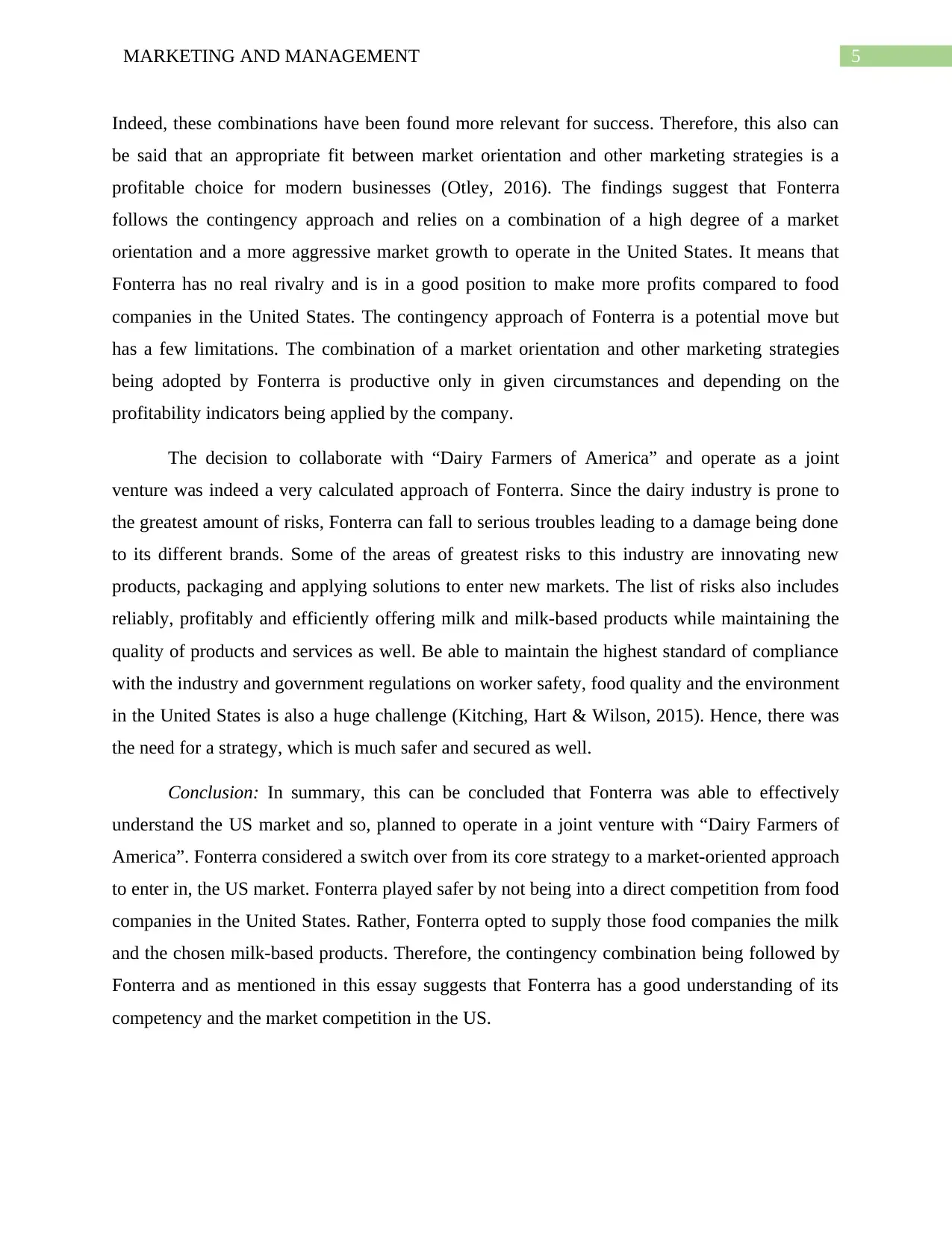
5MARKETING AND MANAGEMENT
Indeed, these combinations have been found more relevant for success. Therefore, this also can
be said that an appropriate fit between market orientation and other marketing strategies is a
profitable choice for modern businesses (Otley, 2016). The findings suggest that Fonterra
follows the contingency approach and relies on a combination of a high degree of a market
orientation and a more aggressive market growth to operate in the United States. It means that
Fonterra has no real rivalry and is in a good position to make more profits compared to food
companies in the United States. The contingency approach of Fonterra is a potential move but
has a few limitations. The combination of a market orientation and other marketing strategies
being adopted by Fonterra is productive only in given circumstances and depending on the
profitability indicators being applied by the company.
The decision to collaborate with “Dairy Farmers of America” and operate as a joint
venture was indeed a very calculated approach of Fonterra. Since the dairy industry is prone to
the greatest amount of risks, Fonterra can fall to serious troubles leading to a damage being done
to its different brands. Some of the areas of greatest risks to this industry are innovating new
products, packaging and applying solutions to enter new markets. The list of risks also includes
reliably, profitably and efficiently offering milk and milk-based products while maintaining the
quality of products and services as well. Be able to maintain the highest standard of compliance
with the industry and government regulations on worker safety, food quality and the environment
in the United States is also a huge challenge (Kitching, Hart & Wilson, 2015). Hence, there was
the need for a strategy, which is much safer and secured as well.
Conclusion: In summary, this can be concluded that Fonterra was able to effectively
understand the US market and so, planned to operate in a joint venture with “Dairy Farmers of
America”. Fonterra considered a switch over from its core strategy to a market-oriented approach
to enter in, the US market. Fonterra played safer by not being into a direct competition from food
companies in the United States. Rather, Fonterra opted to supply those food companies the milk
and the chosen milk-based products. Therefore, the contingency combination being followed by
Fonterra and as mentioned in this essay suggests that Fonterra has a good understanding of its
competency and the market competition in the US.
Indeed, these combinations have been found more relevant for success. Therefore, this also can
be said that an appropriate fit between market orientation and other marketing strategies is a
profitable choice for modern businesses (Otley, 2016). The findings suggest that Fonterra
follows the contingency approach and relies on a combination of a high degree of a market
orientation and a more aggressive market growth to operate in the United States. It means that
Fonterra has no real rivalry and is in a good position to make more profits compared to food
companies in the United States. The contingency approach of Fonterra is a potential move but
has a few limitations. The combination of a market orientation and other marketing strategies
being adopted by Fonterra is productive only in given circumstances and depending on the
profitability indicators being applied by the company.
The decision to collaborate with “Dairy Farmers of America” and operate as a joint
venture was indeed a very calculated approach of Fonterra. Since the dairy industry is prone to
the greatest amount of risks, Fonterra can fall to serious troubles leading to a damage being done
to its different brands. Some of the areas of greatest risks to this industry are innovating new
products, packaging and applying solutions to enter new markets. The list of risks also includes
reliably, profitably and efficiently offering milk and milk-based products while maintaining the
quality of products and services as well. Be able to maintain the highest standard of compliance
with the industry and government regulations on worker safety, food quality and the environment
in the United States is also a huge challenge (Kitching, Hart & Wilson, 2015). Hence, there was
the need for a strategy, which is much safer and secured as well.
Conclusion: In summary, this can be concluded that Fonterra was able to effectively
understand the US market and so, planned to operate in a joint venture with “Dairy Farmers of
America”. Fonterra considered a switch over from its core strategy to a market-oriented approach
to enter in, the US market. Fonterra played safer by not being into a direct competition from food
companies in the United States. Rather, Fonterra opted to supply those food companies the milk
and the chosen milk-based products. Therefore, the contingency combination being followed by
Fonterra and as mentioned in this essay suggests that Fonterra has a good understanding of its
competency and the market competition in the US.
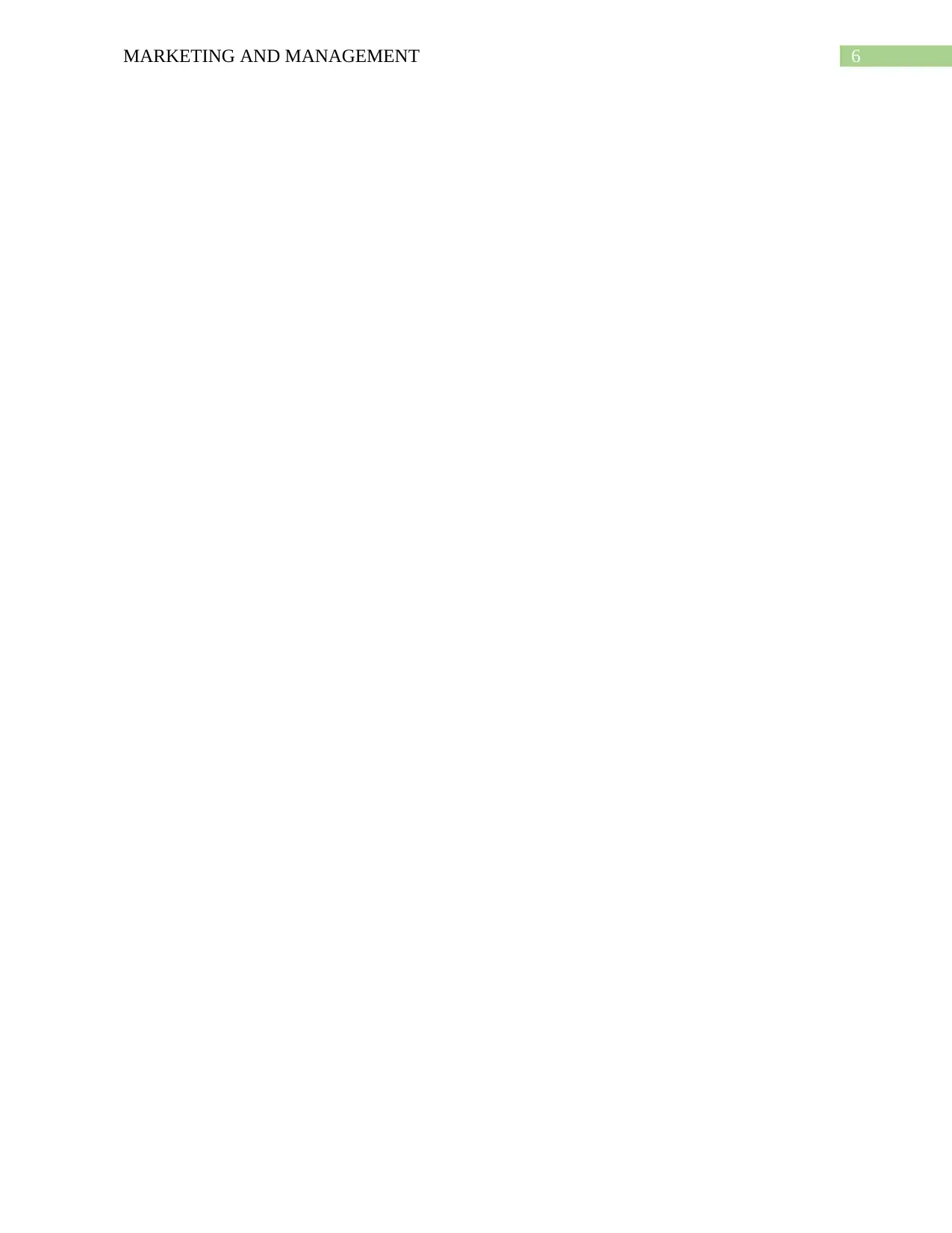
6MARKETING AND MANAGEMENT
Paraphrase This Document
Need a fresh take? Get an instant paraphrase of this document with our AI Paraphraser
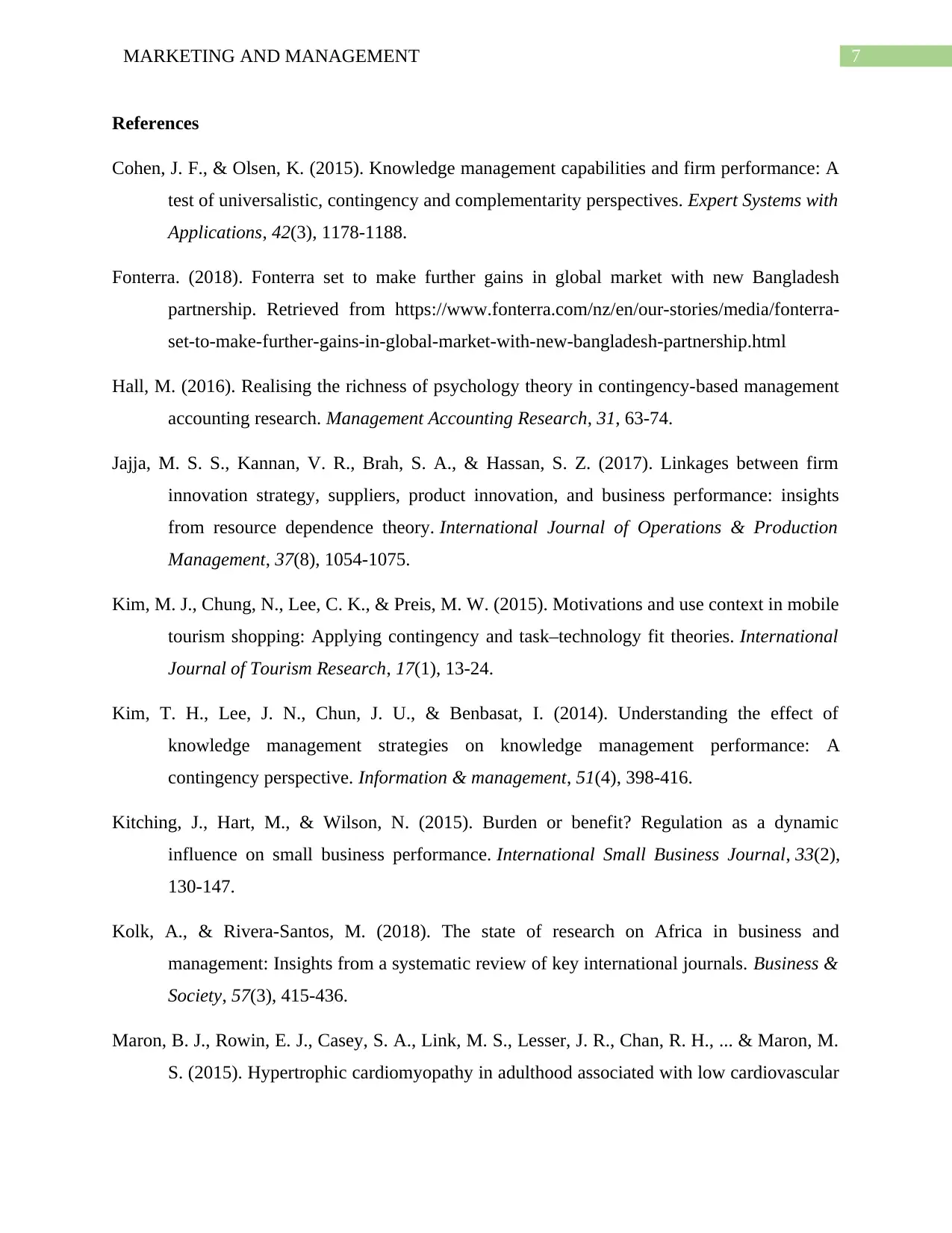
7MARKETING AND MANAGEMENT
References
Cohen, J. F., & Olsen, K. (2015). Knowledge management capabilities and firm performance: A
test of universalistic, contingency and complementarity perspectives. Expert Systems with
Applications, 42(3), 1178-1188.
Fonterra. (2018). Fonterra set to make further gains in global market with new Bangladesh
partnership. Retrieved from https://www.fonterra.com/nz/en/our-stories/media/fonterra-
set-to-make-further-gains-in-global-market-with-new-bangladesh-partnership.html
Hall, M. (2016). Realising the richness of psychology theory in contingency-based management
accounting research. Management Accounting Research, 31, 63-74.
Jajja, M. S. S., Kannan, V. R., Brah, S. A., & Hassan, S. Z. (2017). Linkages between firm
innovation strategy, suppliers, product innovation, and business performance: insights
from resource dependence theory. International Journal of Operations & Production
Management, 37(8), 1054-1075.
Kim, M. J., Chung, N., Lee, C. K., & Preis, M. W. (2015). Motivations and use context in mobile
tourism shopping: Applying contingency and task–technology fit theories. International
Journal of Tourism Research, 17(1), 13-24.
Kim, T. H., Lee, J. N., Chun, J. U., & Benbasat, I. (2014). Understanding the effect of
knowledge management strategies on knowledge management performance: A
contingency perspective. Information & management, 51(4), 398-416.
Kitching, J., Hart, M., & Wilson, N. (2015). Burden or benefit? Regulation as a dynamic
influence on small business performance. International Small Business Journal, 33(2),
130-147.
Kolk, A., & Rivera-Santos, M. (2018). The state of research on Africa in business and
management: Insights from a systematic review of key international journals. Business &
Society, 57(3), 415-436.
Maron, B. J., Rowin, E. J., Casey, S. A., Link, M. S., Lesser, J. R., Chan, R. H., ... & Maron, M.
S. (2015). Hypertrophic cardiomyopathy in adulthood associated with low cardiovascular
References
Cohen, J. F., & Olsen, K. (2015). Knowledge management capabilities and firm performance: A
test of universalistic, contingency and complementarity perspectives. Expert Systems with
Applications, 42(3), 1178-1188.
Fonterra. (2018). Fonterra set to make further gains in global market with new Bangladesh
partnership. Retrieved from https://www.fonterra.com/nz/en/our-stories/media/fonterra-
set-to-make-further-gains-in-global-market-with-new-bangladesh-partnership.html
Hall, M. (2016). Realising the richness of psychology theory in contingency-based management
accounting research. Management Accounting Research, 31, 63-74.
Jajja, M. S. S., Kannan, V. R., Brah, S. A., & Hassan, S. Z. (2017). Linkages between firm
innovation strategy, suppliers, product innovation, and business performance: insights
from resource dependence theory. International Journal of Operations & Production
Management, 37(8), 1054-1075.
Kim, M. J., Chung, N., Lee, C. K., & Preis, M. W. (2015). Motivations and use context in mobile
tourism shopping: Applying contingency and task–technology fit theories. International
Journal of Tourism Research, 17(1), 13-24.
Kim, T. H., Lee, J. N., Chun, J. U., & Benbasat, I. (2014). Understanding the effect of
knowledge management strategies on knowledge management performance: A
contingency perspective. Information & management, 51(4), 398-416.
Kitching, J., Hart, M., & Wilson, N. (2015). Burden or benefit? Regulation as a dynamic
influence on small business performance. International Small Business Journal, 33(2),
130-147.
Kolk, A., & Rivera-Santos, M. (2018). The state of research on Africa in business and
management: Insights from a systematic review of key international journals. Business &
Society, 57(3), 415-436.
Maron, B. J., Rowin, E. J., Casey, S. A., Link, M. S., Lesser, J. R., Chan, R. H., ... & Maron, M.
S. (2015). Hypertrophic cardiomyopathy in adulthood associated with low cardiovascular
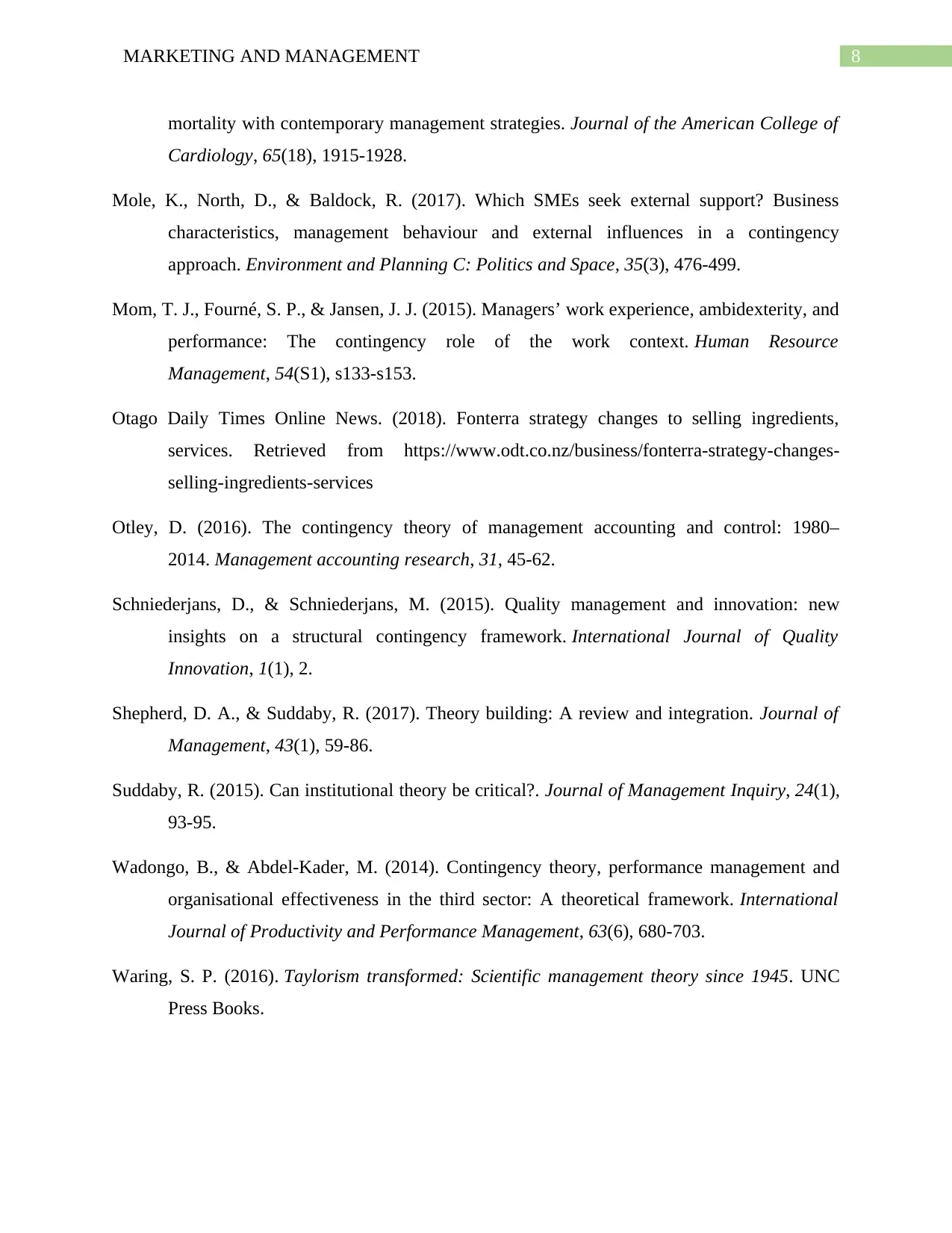
8MARKETING AND MANAGEMENT
mortality with contemporary management strategies. Journal of the American College of
Cardiology, 65(18), 1915-1928.
Mole, K., North, D., & Baldock, R. (2017). Which SMEs seek external support? Business
characteristics, management behaviour and external influences in a contingency
approach. Environment and Planning C: Politics and Space, 35(3), 476-499.
Mom, T. J., Fourné, S. P., & Jansen, J. J. (2015). Managers’ work experience, ambidexterity, and
performance: The contingency role of the work context. Human Resource
Management, 54(S1), s133-s153.
Otago Daily Times Online News. (2018). Fonterra strategy changes to selling ingredients,
services. Retrieved from https://www.odt.co.nz/business/fonterra-strategy-changes-
selling-ingredients-services
Otley, D. (2016). The contingency theory of management accounting and control: 1980–
2014. Management accounting research, 31, 45-62.
Schniederjans, D., & Schniederjans, M. (2015). Quality management and innovation: new
insights on a structural contingency framework. International Journal of Quality
Innovation, 1(1), 2.
Shepherd, D. A., & Suddaby, R. (2017). Theory building: A review and integration. Journal of
Management, 43(1), 59-86.
Suddaby, R. (2015). Can institutional theory be critical?. Journal of Management Inquiry, 24(1),
93-95.
Wadongo, B., & Abdel-Kader, M. (2014). Contingency theory, performance management and
organisational effectiveness in the third sector: A theoretical framework. International
Journal of Productivity and Performance Management, 63(6), 680-703.
Waring, S. P. (2016). Taylorism transformed: Scientific management theory since 1945. UNC
Press Books.
mortality with contemporary management strategies. Journal of the American College of
Cardiology, 65(18), 1915-1928.
Mole, K., North, D., & Baldock, R. (2017). Which SMEs seek external support? Business
characteristics, management behaviour and external influences in a contingency
approach. Environment and Planning C: Politics and Space, 35(3), 476-499.
Mom, T. J., Fourné, S. P., & Jansen, J. J. (2015). Managers’ work experience, ambidexterity, and
performance: The contingency role of the work context. Human Resource
Management, 54(S1), s133-s153.
Otago Daily Times Online News. (2018). Fonterra strategy changes to selling ingredients,
services. Retrieved from https://www.odt.co.nz/business/fonterra-strategy-changes-
selling-ingredients-services
Otley, D. (2016). The contingency theory of management accounting and control: 1980–
2014. Management accounting research, 31, 45-62.
Schniederjans, D., & Schniederjans, M. (2015). Quality management and innovation: new
insights on a structural contingency framework. International Journal of Quality
Innovation, 1(1), 2.
Shepherd, D. A., & Suddaby, R. (2017). Theory building: A review and integration. Journal of
Management, 43(1), 59-86.
Suddaby, R. (2015). Can institutional theory be critical?. Journal of Management Inquiry, 24(1),
93-95.
Wadongo, B., & Abdel-Kader, M. (2014). Contingency theory, performance management and
organisational effectiveness in the third sector: A theoretical framework. International
Journal of Productivity and Performance Management, 63(6), 680-703.
Waring, S. P. (2016). Taylorism transformed: Scientific management theory since 1945. UNC
Press Books.
1 out of 9
Related Documents
Your All-in-One AI-Powered Toolkit for Academic Success.
+13062052269
info@desklib.com
Available 24*7 on WhatsApp / Email
![[object Object]](/_next/static/media/star-bottom.7253800d.svg)
Unlock your academic potential
© 2024 | Zucol Services PVT LTD | All rights reserved.





